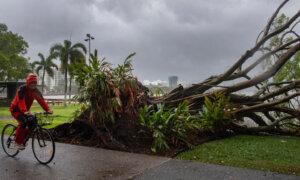The Bureau of Meteorology issued a major flood warning for the river on Sunday morning, with property, livestock, equipment, and crops all likely to be threatened by floodwaters.
Emergency services responded to 330 incidents in the 24 hours to 8 a.m. on Sunday, with a host of warnings issued for extreme weather expected for the next few days.
People in southeast Tasmanian towns on the Derwent—including Meadowbank, Glenora, Bushy Park, Gretna and Macquarie Plains—are being urged to enact flood emergency plans and prepare their properties for inundation.
That includes putting furniture and possessions in high locations and moving livestock to higher ground.
If conditions get worse, residents should leave their properties if safe to do so and go to a more secure location.
“Tasmania SES has issued a Flood Watch and Act for communities along the Derwent River .. please prepare now to go to a safer place if conditions become more dangerous,” Executive Director Mick Lowe said.
“There is potential for properties to be inundated, and roads may not be accessible … if flooding in your area occurs, remember, never drive or enter floodwaters.”
An evacuation centre has been opened in New Norfolk.
Severe winds and gale-force gusts have buffeting Tasmania, South Australia and Victoria, while Queensland is sweltering in near-record temperatures after the nation’s outback interior roasted during the week.
Gusts of up to 110km/h are likely in Tasmania, potentially reaching 125km/h in parts.
A 156km/h gust was recorded in the state’s northwest on Saturday morning.
On the south coast, Maatsuyker Island recorded a gust of 165km/h, about as strong as a category three tropical cyclone, the Bureau of Meteorology said.
As a result, the Spirit of Tasmania cancelled a scheduled trip from Devonport to Geelong on Saturday night.
Passengers were told they could board the vessel and stay onboard overnight then start their journey back to the mainland at 7.30 a.m. on Sunday.
Speaking on Saturday, Tasmanian Premier Jeremy Rockliff said 1,500 properties were still without power, with more wild weather on the way.
“Please heed the warnings ... we have extremely rare and dangerous winds, rising floodwaters and 1,500 Tasmanians without power,” he said.
“Please make informed decisions ... in what could be a very dangerous next 24 hours.”
The premier thanked emergency services and power technicians who were working to protect and help those affected by the wild weather.
Across the Bass Strait in Victoria, damaging winds continue in the south after power was restored to more than 20,000 customers in the state’s centre and west following destructive winds during the week.
In Queensland, winter has ended with unseasonably warm temperatures nearing 40C in the state’s west.
A top of 34C was forecast in Brisbane, nudging an August record 35.4C, but parts of the city could reach up to 36C.
Queensland recorded its hottest August day on Friday at Birdsville, near the SA border, with a top of 39.7C.
Warmer-than-usual temperatures are likely to continue around Australia in spring following above-average temperatures in winter, with August expected to have been the nation’s warmest on record.
Several heat records fell in the final week of the month including Australia’s hottest winter temperature - at Yampi Sound, northeast of Broome in WA.







